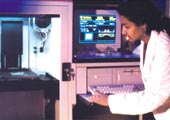 |
|
Rapid PrototypingIn the late 1960s, Herbert Voelcker—then an engineering professor at the University of Rochester, now at Cornell University—went on sabbatical and asked himself how to do "interesting things" with the automatic, computer-controlled machine tools that were just beginning to appear on factory floors. In particular, Voelcker wanted to find a way to take the output from a computer design program and use it to program the automatic machine tools. With funding from NSF, Voelcker tackled the problem first by developing the basic mathematical tools needed to unambiguously describe three-dimensional parts (see the chapter on Visualization: Staking the Pioneers). The result was the early mathematical theory and algorithms of solid modeling that today form the basis of computer programs used to design almost everything mechanical, from toy cars to skyscrapers. 
During the 1970s, Voelcker's work transformed the way products were designed, but for the most part they were still made the same old way. That is, either a machinist or a computer-controlled machine tool would cut away at a hunk of metal until what remained was the required part, in much the same way as Michelangelo removed chips of marble from a block until all that remained was a statue of David. But then in 1987, University of Texas researcher Carl Deckard came up with a better idea. Instead of making a part by cutting away at a larger chunk of material, why not build it up layer by layer? Deckard imagined "printing" three-dimensional models by using laser light to fuse metallic powder into solid prototypes, one layer at a time. Deckard took his idea—considered too speculative by industry—to NSF, which awarded him a $50,000 Small Grant for Exploratory Research (SGER) to pursue what he called "selective laser sintering." Deckard's initial results were promising and in the late 1980s his team was awarded one of NSF's first Strategic Manufacturing (STRATMAN) Initiative grants, given to the kind of interdisciplinary groups often necessary for innovation in the realm of manufacturing. The result of Voelcker's and Deckard's efforts has been an important new industry called "free form fabrication" or "rapid prototyping" that has revolutionized how products are designed and manufactured. An engineer sits down at a computer and sketches her ideas on screen with a computer-aided design program that allows her to make changes almost as easily as a writer can change a paragraph. When it's done, the design can then be "printed" on command, almost as easily as a writer can print a draft—except this draft is a precise, three-dimensional object made of metal or plastic. The method can be used to make things that are more than prototypes. "Because you can control it in this incredible way, you can make objects that you just couldn't think of machining before," says George Hazelrigg, group leader of DMII's research programs. "For example, you can make a ship in a bottle." More practically, the method has been used to make a surface with lots of tiny hooks that resembles Velcro. These new surfaces are proving to be ideal substrates for growing human tissue. "So these are pretty fundamental things," Hazelrigg says. "I think it's fair to say that we played a major role in it." Bruce Kramer, acting division director of NSF's Engineering and Education Centers, is even more definite: "For a majority of successful rapid prototyping technologies, the first dollar into the technology was an NSF dollar." |
||
Search | Site map | NSF Home | OLPA Home
| Questions |